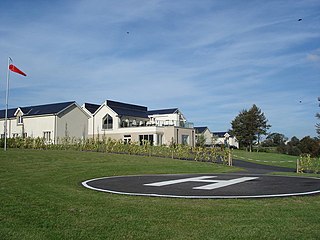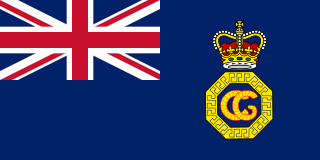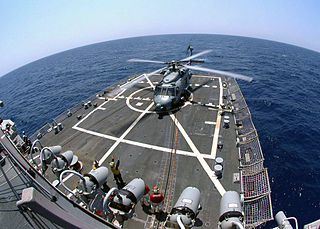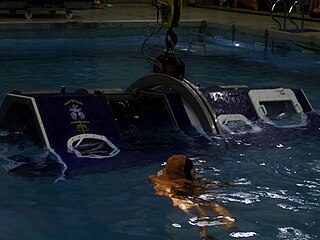
Search and rescue (SAR) is the search for and provision of aid to people who are in distress or imminent danger. The general field of search and rescue includes many specialty sub-fields, typically determined by the type of terrain the search is conducted over. These include mountain rescue; ground search and rescue, including the use of search and rescue dogs ; urban search and rescue in cities; combat search and rescue on the battlefield and air-sea rescue over water.

A heliport, sometimes referred to as a vertiport, are small airports which has a helipad, suitable for use by helicopters, powered lift aircrafts, and various types of vertical lift aircraft.

A helipad is the landing area of a heliport, in use by helicopters, powered lift aircrafts, and vertical lift aircrafts to land on surface.

His Majesty's Coastguard (HMCG) is the section of the Maritime and Coastguard Agency responsible, through the Secretary of State for Transport to Parliament, for the initiation and co-ordination of all maritime search and rescue (SAR) within the UK Maritime Search and Rescue Region. This includes the mobilisation, organisation and tasking of adequate resources to respond to persons either in distress at sea, or to persons at risk of injury or death on the cliffs or shoreline of the United Kingdom. Since 2015 it has also been responsible for land-based search and rescue helicopter operations.

Piper Alpha was an oil platform located in the North Sea about 120 miles (190 km) north-east of Aberdeen, Scotland. It was operated by Occidental Petroleum (Caledonia) Limited (OPCAL) and began production in December 1976, initially as an oil-only platform, but later converted to add gas production.

A diving support vessel is a ship that is used as a floating base for professional diving projects. Basic requirements are the ability to keep station accurately and reliably throughout a diving operation, often in close proximity to drilling or production platforms, for positioning to degrade slowly enough in deteriorating conditions to recover divers without excessive risk, and to carry the necessary support equipment for the mode of diving to be used.

The Sikorsky S-92 is an American twin-engine medium-lift helicopter built by Sikorsky Aircraft for the civil and military helicopter markets. The S-92 was developed from the Sikorsky S-70 helicopter and has similar parts such as flight control and rotor systems.

The Boeing MH-6M Little Bird and its attack variant, the AH-6, are light helicopters used for special operations in the United States Army. Originally based on a modified OH-6A, it was later based on the MD 500E, with a single five-bladed main rotor. The newest version, the MH-6M, is based on the MD 530F and has a single, six-bladed main rotor and four-bladed tail rotor.
Seafaring is a tradition that encompasses a variety of professions and ranks. Each of these roles carries unique responsibilities that are integral to the successful operation of a seafaring vessel. A ship's crew can generally be divided into four main categories: the deck department, the engineering department, the steward's department, and other. The reasoning behind this is that a ship's bridge, filled with sophisticated navigational equipment, requires skills differing from those used on deck operations – such as berthing, cargo and/or military devices – which in turn requires skills different from those used in a ship's engine room and propulsion, and so on.

A helicopter deck is a helicopter pad on the deck of a ship, usually located on the stern and always clear of obstacles that would prove hazardous to a helicopter landing. In the United States Navy, it is commonly and properly referred to as the flight deck.
Bristow Helicopters Limited is a British civil helicopter operator originally based at Aberdeen Airport, Scotland, which is currently a part of the U.S.-based Bristow Group which in turn has its corporate headquarters in Houston, Texas, U.S. In 2020, Bristow Group was merged with Era Helicopters, a large U.S.-based commercial helicopter operator that was previously a division of Era Aviation, with the two companies then continuing to use the Bristow name.
Sector Commander is the position title of the commanding officer of a United States Coast Guard Sector, usually of the rank of Captain (O-6). The Sector Commander's second-in-command is the Deputy Sector Commander. Also reporting directly to the Sector Commander are the Command Master Chief (CMC), the Senior Reserve Officer, and the Sector's Auxiliary Coordinator.

Helicopter Underwater Egress Training ; often abbreviated as HUET, pronounced hue-wet, hue-way or you-way) is training provided to helicopter flight crews, offshore oil and gas industry, law enforcement personnel, and military personnel who are regularly transported by helicopters over water. As the name implies, the purpose of this training is to prepare passengers and crew for an emergency evacuation or egress in the event of a crash landing on water.

Cougar Helicopters Flight 91 was a scheduled flight of a Cougar Sikorsky S-92A which ditched on 12 March 2009 en route to the SeaRose FPSO in the White Rose oil field and Hibernia Platform in the Hibernia oilfield off the coast of Newfoundland 55 kilometres (34 mi) east-southeast of St. John's, Newfoundland. Of the 18 aboard, only one survived.
The Elgin–Franklin fields are two adjacent gas condensate fields located in the Central Graben Area of the North Sea 240 kilometres (130 nmi) east of Aberdeen, Scotland at a water depth of 93 metres (305 ft). The joint development of the Elgin and Franklin fields is the largest high pressure high temperature development in the world, and also contains the world's hottest, highest temperature field, West Franklin, and the Glenelg field.

An accommodation platform is an offshore platform which supports living quarters for offshore personnel. These are often associated with the petroleum industry, although other industries use them as well, such as the wind farm Horns Rev 2.

A sailor, seaman, mariner, or seafarer is a person who works aboard a watercraft as part of its crew, and may work in any one of a number of different fields that are related to the operation and maintenance of a ship.

Fedje Heliport, Høgden is a municipal heliport situated on the island of Fedje in Fedje, Norway. It is predominantly used to fly maritime pilots out of the pilot station at Fedje Vessel Traffic Service Centre. It is also used by air ambulances and as an emergency landing site for offshore helicopters. The heliport was built in 1994.













